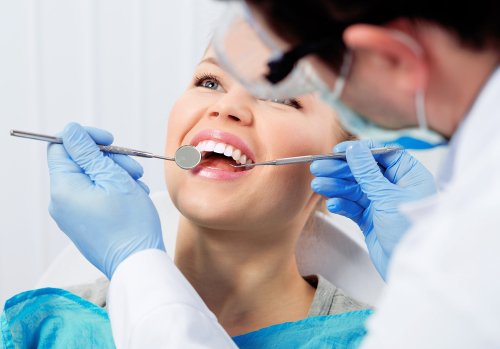An Unbiased View of Legacy Orthodontics
An Unbiased View of Legacy Orthodontics
Blog Article
9 Simple Techniques For Legacy Orthodontics
Table of ContentsRumored Buzz on Legacy Orthodontics6 Simple Techniques For Legacy OrthodonticsSome Of Legacy OrthodonticsWhat Does Legacy Orthodontics Do?Some Known Details About Legacy Orthodontics
In enhancement, we offer adjustable therapy routines, adaptable settlement options and a fun, enjoyable experience.An orthodontist is a dental professional trained to detect, prevent, and treat teeth and jaw irregularities. Orthodontists function with individuals of all ages, from children to adults.
Malocclusion, or misaligned teeth, can bring about dental issues, including tooth decay, gum tissue illness, and hard or agonizing eating. Not everyone is born with straight teeth. If you have a poor bite or large rooms between your teeth, you may desire to speak with a dentist concentrating on orthodontic care.
Getting My Legacy Orthodontics To Work
( Photo Credit Scores: DigitalVision/Getty Images) Orthodontists make use of repaired and detachable dental tools, like braces, retainers, and bands, to alter the setting of teeth in your mouth. Orthodontic treatment is for oral irregularities, including: Uneven teethBite problems, like an overbite or an underbiteCrowded teeth or teeth that are also much apartJaw misalignmentThe goal of orthodontic treatment is to boost your bite.
A healthy bite guarantees you can eat, chew, and talk effectively. While you might think about orthodontists as mainly for kids or young adults that need dental braces, they can fix oral problems at any age. Orthodontists attend college, dental school, and orthodontic school. After graduation, they spend 2 or 3 years in an orthodontic residency program.
, however not all dental practitioners are orthodontists. They concentrate on two areas: How to correctly and safely relocate teeth How to appropriately assist advancement in the teeth, jaw, and faceOnce an orthodontist has finished training, they have the alternative to come to be board certified.
The Best Strategy To Use For Legacy Orthodontics
Malocclusion leads to tooth overcrowding, an irregular jaw, or irregular bite patterns. Malocclusion is usually treated with: Your orthodontist connects metal, ceramic, or plastic square bonds to your teeth.
If you have only minor malocclusion, you may have the ability to make use of clear dental braces, called aligners, as opposed to standard braces (https://www.topratedlocal.com/legacy-orthodontics2-reviews). Some individuals need a headgear to help move teeth right into line with stress from outside the mouth. After braces or aligners, you'll need to wear a retainer. A retainer is a personalized tool that maintains your teeth in position.
They're frequently made use of on youngsters. They can create added area in the mouth without having to pull teeth. If you have a severe underbite or overbite, you could need orthognathic surgical treatment (additionally called orthodontic surgical procedure) to lengthen or reduce your jaw. Orthodontists use cables, surgical screws, or plates to support your jaw bone.
You may require to see an orthodontist if you have: Crowding or otherwise sufficient area for all of your teethOverbite, when your upper teeth come over your bottom teethUnderbite, when your base teeth are also much forwardSpacing or problems with gapsCrossbite, which is when your upper teeth fit behind your base teeth when your mouth is closedOpen bite or an upright void between your front bottom and top teethMisplaced midline, when the center of your bottom and top teeth don't line up Correcting a dental malocclusion can: Make biting, eating, and speaking easierImprove the proportion of our face and your general appearanceEase pain from temporomandibular joint conditionsDifferent your teeth and make them much easier to clean up, aiding avoid dental cavity or dental caries It's often a dentist that initially notifications misaligned teeth during a regular examination.
Legacy Orthodontics - An Overview

Throughout your first orthodontic examination, you'll likely have: An oral examPhotos taken of your face and smileDental X-raysPanoramic (360 degree) X-rays of your face and headImpressions to develop molds of your teethThese tests will help your orthodontist recognize how to proceed with your therapy. leesburg clear braces. An orthodontist is a dentist that's had training to treat your teeth and jaw
An orthodontist is focused on your bite, so something like a cracked tooth would certainly be taken care of by a dental expert. Orthodontists are focused on your bite, or the means your teeth fit with each other, and the straightness of your teeth.
Ever before questioned just how celebrities always seem you could look here to have completely aligned teeth? Orthodontists are dental specialists who concentrate on correcting abnormalities in the teeth and jaws.
The 7-Minute Rule for Legacy Orthodontics

, orthodontists have a diverse toolkit at their disposal. These reliable braces utilize a system of brackets bonded to the teeth and connected by cables.
Clear aligners, like Invisalign, are a popular option for people seeking a much more discreet therapy choice. These detachable trays are personalized to gradually change the teeth's position. Headgear might be used combined with dental braces or aligners to apply additional targeted pressures, specifically for correcting jaw inconsistencies. In situations of slim jaws, palatal expanders can be utilized to produce area for correct tooth positioning.
Report this page